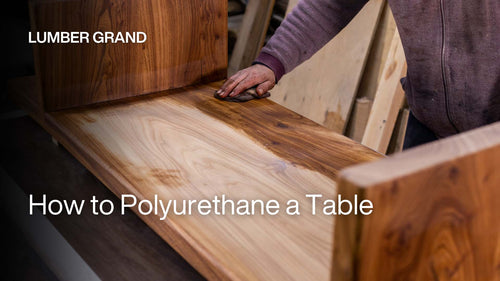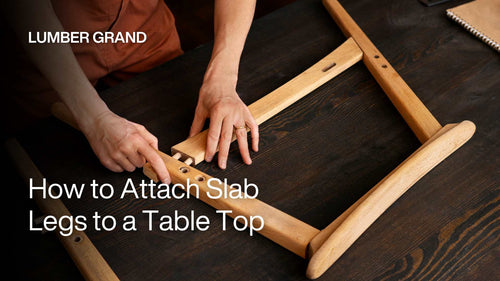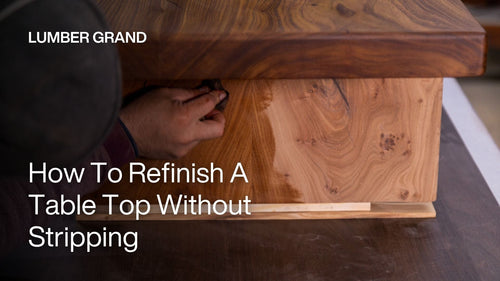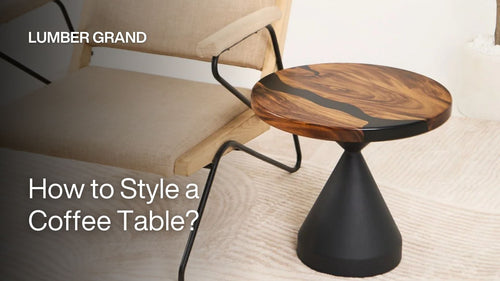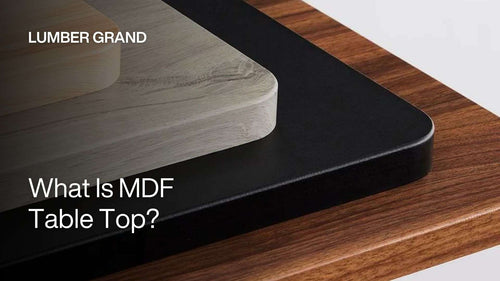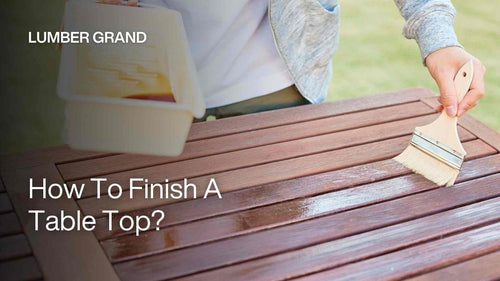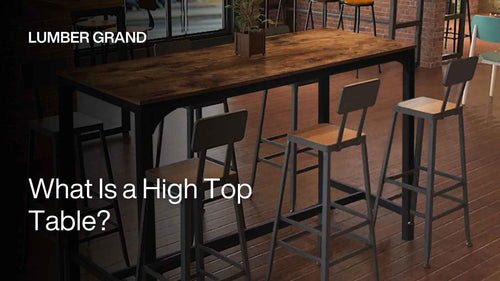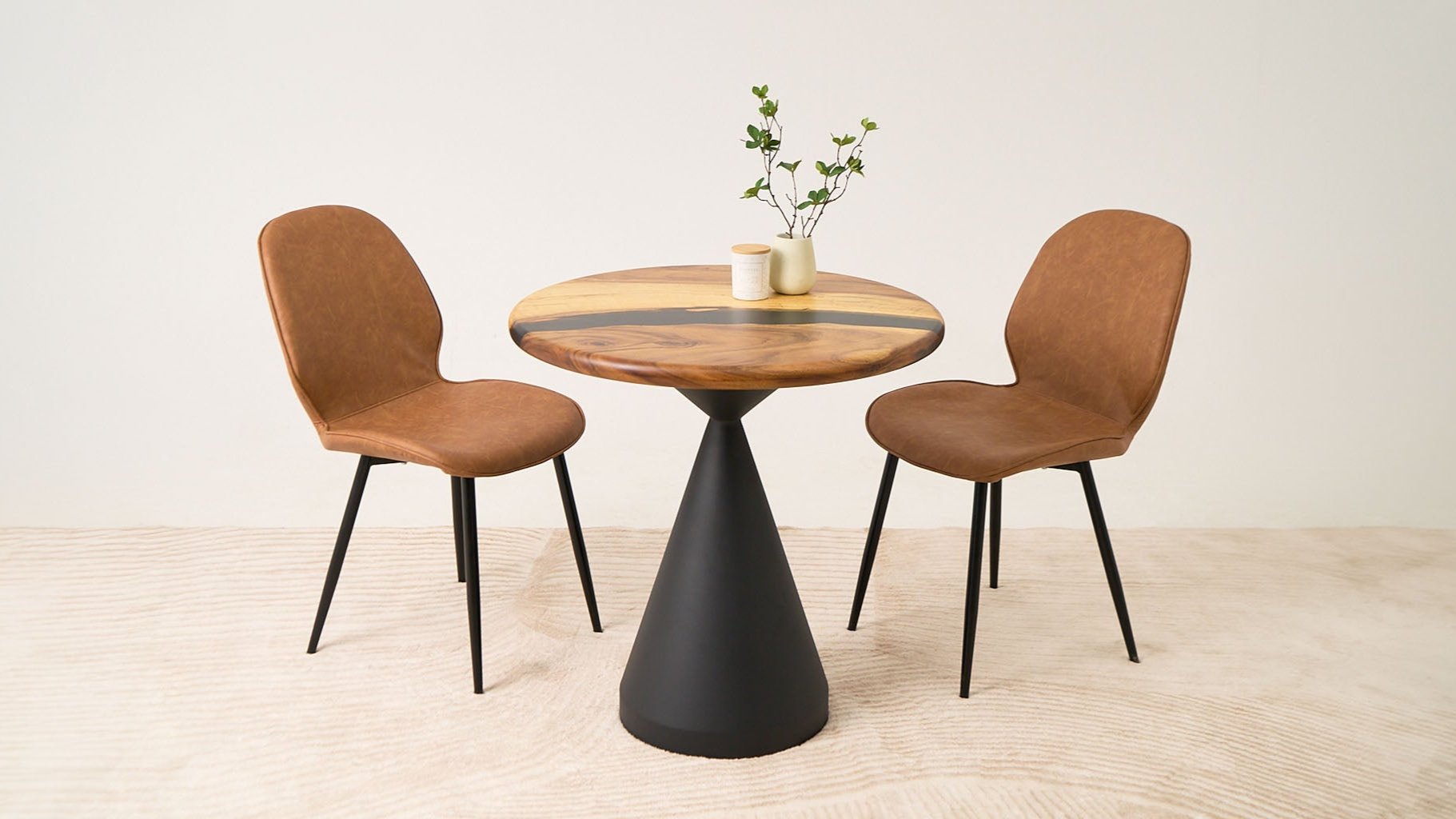Most people don't realize that learning how to fix a wobbly table doesn't always require tools. You can actually solve it quickly with a simple quarter-turn rotation.
Nothing ruins a nice dinner quite like a wobbly table that makes your wine glass dance every time someone cuts their steak. So, before you stuff another napkin under that short leg or give up entirely, you should know these 9 best ways on how to fix wobbly legs, from the 30-second wine cork trick to installing proper table stabilizers.
Lumber Grand experts are here to help one by one. Read more!
Why Are My Table Legs Wobbly? 6 Popular Causes
The wobbly table meaning essentially refers to any table that moves, rocks, or shakes when pressure is applied.
Let's figure out the 6 common reasons that are making your wobbly table legs, so we can get it fixed.
-
Loose hardware: Every time you pull table out to vacuum underneath or slide it over for a party, those screws and bolts get a little workout. After months or years of this, they start getting loose.
-
Uneven leg height: Sometimes one leg decides to be different from the others. Maybe it got damaged, it was made slightly shorter, or years of use have worn it down more than its buddies. When legs aren't the same height, your table turns into a seesaw.
-
Weak or damaged table legs: Tables get bumped by vacuum cleaners, kicked by accident, and bear the weight of everything you put on top. Now, they get tired, weak, or damaged enough that they can't stay stable anymore.
-
Worn-out joints: The legs connect to the table top through various joints and connections. And these joints can get worn out from supporting weight day after day. Heavy family dinners, kids doing homework, and general daily life all add wobbly table top over time.
-
Failed attachment methods: All those brackets, screws, and metal pieces that hold your table together can bend, break, or simply lose their grip. Then, it leaves your table barely hanging on.
-
Warped or uneven flooring: Most floors look perfectly level to the naked eye, but they're actually full of tiny hills and valleys. When one leg hits a low spot or sits on a small high point, it causes the table wobbles side to side. This is especially common when you need to know how to fix a wobbly metal table leg.
You might like: How to Brace a Table Top
3 Easy Methods to Fix a Wobbly Table in a Few Seconds
You can fix a wobbly desk just by turning it. We know it sounds wild, but there's actually solid reasoning behind this old handyman trick. There's a more surprising trick that you’ll want to know, check more below!
1. The Quarter-Turn Method (Fix Woobly Table by Rotating with Math)
The quarter-turn method is based on a fascinating mathematical principle that works specifically for four-legged tables on uneven surfaces.
The science behind the method: When a four-legged table sits on an uneven floor, the surface creates what mathematicians call a "twisted quadrilateral" — essentially, the four contact points don't lie in the same plane.
However, by rotating the table 90 degrees (a quarter turn), you're essentially sampling different points on the floor surface until you find a position where all four legs can make stable contact.

Using the quarter-turn method to fix a wobbly table
Photo: Numberphile
Here's how to fix a wobbly table with a quarter-turn:
-
Clear the table surface completely to make rotation easier and safer
-
Mark the starting position by placing a piece of tape on both the table edge and the floor so you can track your progress
-
Lift one side slightly and rotate the entire table 90 degrees clockwise
-
Test for stability by gently pressing down on each corner of the table
-
Continue rotating in quarter turns if wobbling persists, and try all four positions (0°, 90°, 180°, 270°)
-
Adjust the position by making small adjustments (15 — 30 degrees) around the most stable quarter-turn position
Best applications: This method works great for wobbly coffee table problems, especially in older homes where the floors have settled over the years. It's also perfect for a wobbly desk on tile floors where some tiles might have shifted slightly.
Note: Although it’s effective, we highly recommend you try this when the floor unevenness is relatively minor (less than 1/4 inch variation). But if your floor looks like a roller coaster, you'll need to try some solutions below, too.
2. Makeshift Shims
Now, how to fix a wobbly table in just a few seconds? Let’s grab whatever's handy, such as:
-
A coaster
-
Fold up a napkin a few times
-
Old matchbook
-
Even tear off a piece of cardboard

How to fix a wobbly table with makeshift shims
Photo: Alamy
You slip it under whichever leg isn't touching the ground properly. Sure, it's not going to win any design awards, but it'll give you an instant fix for a wobbly table that actually works.
3. Wine Cork Trick
With this hack, we'll take a wine cork and slice off a disc that's about the right thickness to level out your table. You can make it thicker or thinner depending on how much lift you need. Once you've got the right size, simply dab a little hot glue on it and stick it under the short leg.

Wine cork hack gives you a great excuse to open a bottle of wine for "research purposes."
Photo: Freepik
How to Fix a Wobbly Table: 9 Popular Yet Effective Solutions
You don't have to ask yourself anymore about how to fix wobbly legs on a table, since we’ll provide you with the 9 best ways to fix it right away.
1. Tighten Loose Hardware
You might be surprised that the solution is as simple as tightening a few screws that have worked themselves loose over time. This is the first case in learning how to fix a table that wobbles:
-
Step 1: Locate the mounting plate that connects the pedestal to the tabletop
-
Step 2: Tighten each screw until it's flush with the mounting plate (please don’t over-tighten)
-
Step 3: Check and tighten any visible leg screws or bolts
-
Step 4: If screws feel loose in their holes, you need to remove them, apply wood glue to the holes, and then immediately reinstall the screws.

Tighten each loose screw until it's flush with the mounting plate (avoid over-tightening)
Photo: Freepik
2. Strengthen Weak Joints
When your wooden table feels loose and wobbly at the connections, it's time to give those joints some extra care.
-
Step 1: If you can see gaps where the legs meet the table top or where different pieces connect, squeeze some wood glue into those spaces.
-
Step 2: We clamp everything together nice and tight while it dries. You'll need to leave it alone for several hours.
-
Step 3: Cross bracing table legs will give your table a backbone. You can use metal brackets that connect diagonally between the legs, or cut some wooden supports to fit. These diagonal supports stop the table from swaying side to side, which is usually what makes it feel wobbly in the first place.
-
Step 4 (optional): L-shaped metal brackets are perfect for tucking up under your table where the legs meet the top. Same goes for metal corner braces — they might not be pretty, but nobody's going to see them once the table's right-side up.
3. Install a Table Stabilizer Bar
When you're tired of messing around with temporary solutions and want something that really works, a table stabilizer bar is your answer. We suggest this method for larger tables or those with pedestal bases.
Here's how to fix a wobbly table with a stabilizer bar:
-
Step 1: You mount this adjustable bar between two opposite legs, kind of like a tension rod but much sturdier.
-
Step 2: Adjust the tension until the wobbling stops completely
4. Use Adjustable Leveling Feet
The 4th method is so simple, you'll wonder why all tables don't come with these from the factory.
Adjustable leveling feet are like having tiny jacks built right into your table legs. They allow you to raise or lower each corner independently until everything sits perfectly level.
-
Step 1: Rotate clockwise to raise the table height
-
Step 2: Rotate counterclockwise to lower the height
-
Step 3: We continue adjusting until the table is completely stable.
5. Upgrade to Self-Adjusting Levelers
Maybe your table gets moved around a lot, or you're running a busy restaurant where nobody has time to crawl under tables adjusting feet all day. In such cases, we can use self-leveling table feet (automatic levelers) instead.
These clever little devices use springs, gravity, or hydraulic pressure to adjust when weight is put on the table automatically.
-
If someone sits down and leans on one side, the levelers instantly compensate to keep everything stable.
-
Or if you move the table to a different spot with a slightly uneven floor, the legs adapt on their own.
6. Add Rubber Pads or Anti-Slip Mats
Rubber pads fix your wobbles, protect your beautiful floors from scratches, and give your table a better grip so it won't slide around.
Most furniture stores carry them in standard sizes like 1-inch, 1.5-inch, and 2-inch rounds, but you can also find ones that fit your table style better.
-
Step 1: Firstly, we measure your table legs, then look for pads that are either the same size or just slightly larger.
-
Step 2: For legs that are just slightly short, you clean the bottom of the short leg first (dust or grime will prevent good adhesion).
-
Step 3: Stick the pad on and press firmly for about 30 seconds
-
Step 4 (optional): If one pad isn't thick enough, you can stack two or even three, but make sure each one is firmly attached before adding the next layer.

How to fix wobbly legs on a table with felt furniture pad
Photo: Freepik
Regarding the anti-slip mats, you slide one of these under your entire table, and it acts like a shock absorber for minor floor irregularities.
-
These mats are thick enough (usually about half an inch) to cushion small bumps and dips in your floor.
-
At the same time, it’s soft enough that table legs can press down slightly into the surface for better contact.
-
Not to mention, they're much easier on your knees if you ever need to crawl under the table for adjustments.
7. Trim Longer Legs
When one leg is clearly longer than the others and no amount of shimming will fix it, we can give that troublemaker a trim. This works best when the difference is more than a quarter-inch.
Here's how to fix a wobbly table by trimming longer legs:
-
Step 1: We rock the table to identify which leg is too long
-
Step 2: Measure the difference by placing coins or paper under the three shorter legs until the table sits level, then you measure that thickness.
-
Step 3: Mark the cutting line on the long leg with a pencil. You need to measure from the bottom up.
-
Step 4: Use a handsaw or mechanical saw to cut the excess
-
Step 5: Test the table and trim more if needed. It's easier to cut more than to add wood back
-
Step 6: Sand the cut end smooth to remove splinters and rough spots
8. Extend Short Legs
When you need just a little extra height on a wooden table leg, installing an adjustable bolt gives you perfect control. This trick works great for minor height differences and lets you adjust the level if you don’t want to use adjustable leveling feet in method 4.
So, how to extend short legs for a wobbly table?
-
Step 1: Drill a pilot hole straight down into the center of the short leg's bottom. Note that the pilot hole must be slightly smaller than your bolt diameter.
-
Step 2: Thread a lag bolt or heavy-duty screw halfway into the hole, leaving about an inch sticking out
-
Step 3: Test the table and adjust the bolt in or out by turning it until the leg reaches the right height
-
Step 4: Stick a felt furniture pad under the bolt head to protect your floor and provide a better grip
Read more: How to Style a Coffee Table
9. Replace Worn Components
Sometimes your table hardware has just reached the end of its useful life, and no amount of tightening or adjusting will bring it back. When that happens, you’ll need to buy some new parts.
Here's how to replace worn table components:
-
Step 1: Remove stripped screws with a screw extractor or drill them out, then you can replace them with new screws of the same size and thread.
-
Step 2: Swap out cracked or warped mounting plates. Don’t forget to bring the old one to the hardware store to find an exact match.
-
Step 3: Replace any bent brackets or broken corner braces with new ones rated for your table's weight
-
Step 4: Upgrade to heavier-duty hardware if the original components seem too flimsy for daily use
How to Fix a Wobbly Antique Table (Special Cases)
Fixing a wobbly antique table requires special care because it may be old, easily breakable, or valuable. Don’t jump right into screw or drilling since it may harm the table.
Here's the careful approach for antique table repairs:
-
Step 1: You should try reversible fixes first, like adjustable feet, rubber pads, or shims that can be removed without leaving marks.
-
Step 2: We don’t cut, drill, or glue anything that can't be undone later. This is because permanent changes can slash the table's value.
-
Step 3: Call a professional furniture restorer for valuable pieces
-
Step 4: Use traditional methods like hide glue instead of modern wood glue if any joint work is needed
-
Step 5: Take photos and keep notes of any repairs for documentation, as future owners will want to know the table's history

When dealing with valuable furniture, knowing how to fix a wobbly antique table requires extra care
Photo: Freepik
How to Fix a Wobbly Folding Table (Portable Solutions)
Folding tables have their special quirks. All those hinges and locks create extra places where things can go wrong. So, how to fix a wobbly table that is folding usually means checking the folding parts first, not just the legs.
-
Step 1: Check every locking mechanism. We press and release each one to make sure it's catching properly and holding tight.
-
Step 2: Inspect all hinges for wear or bent parts that prevent the legs from locking in the fully extended position
-
Step 3: Tighten every bolt and adjustment screw you can find. As we all know, folding tables have lots of moving parts that work loose over time.
-
Step 4: Replace any worn locking pins, springs, or brackets that aren't holding the legs securely in place
-
Step 5: Add rubber pads where the legs contact the tabletop frame to reduce play and vibration
-
Step 6 (optional): If the folding mechanism is shot, you should upgrade to a heavy-duty replacement. A basic folding hardware never gets better with age.
FAQ
1. How do You Stabilize a Wobbly Table?
The fastest way to stabilize a wobbly table is to try the quarter-turn method first. You simply rotate your table 90 degrees to see if it sits better on your uneven floor. And other solutions like:
-
If that doesn't work, you should check underneath for loose screws and tighten them up.
-
For a quick fix, we slip a folded napkin or rubber pad under the short leg.
-
For permanent stability, you can install a table stabilizer bar between opposite legs or add adjustable leveling feet.
2. How to Fix a Wobbly Standing Table?
Standing tables wobble for the same reasons as regular tables, but the height makes the movement more noticeable. Here is how to fix a wooby standing table:
-
Step 1: Tighten all bolts and screws at the base and where the legs attach.
-
Step 2: Check if the base is sitting flat on the floor. Then you can use adjustable feet if needed.
-
Step 3 (optional): For pedestal-style standing tables, a stabilizer bar works wonders.
-
Step 4 (optional): If you own a folding standing table, you’ll need to inspect all the locking mechanisms and hinges for wear.
3. What to Put Under a Table to Level It?
For quick fixes, you can put these things under a table to level it:
-
Folded napkins, matchbooks, or rubber pads under the short leg.
-
Wine cork slices work great and look more intentional.
-
Adjustable rubber furniture pads that stick to the leg bottom.
-
Anti-fatigue mats under the entire table work well for slightly uneven floors.
-
Adjustable leveling feet or cut a wooden shim to the exact thickness needed.
How to Fix a Wobbly Table: Guide Ends Here
Yet, sometimes a table is just too far gone to save. When you've tried everything and it's still driving you crazy, it might be time to admit defeat and start fresh.
You can take a look at our collection of solid, well-built epoxy dining tables that are designed to stay stable for decades. If you're not sure what would work best in your home, give our furniture folks a message. We love helping people find tables that'll make mealtime pleasant again.
So, we’ve gone through many proven effective ways to fix a wobbly table. Most of the time, it's just a matter of finding the right simple solution, such as:
-
Try the quarter-turn trick by spinning your table to find a better spot on your floor
-
Tighten loose screws that have worked themselves free over the years
-
Slip a rubber pad or folded napkin under the short leg
-
Check if anything just needs a good push back into place
-
Etc
With these proven methods, you'll never have to wonder how to fix a wobbly table again. For more furniture care tips, don’t forget to check out our other helpful guides on maintaining your dining room furniture. Thank you for reading!










